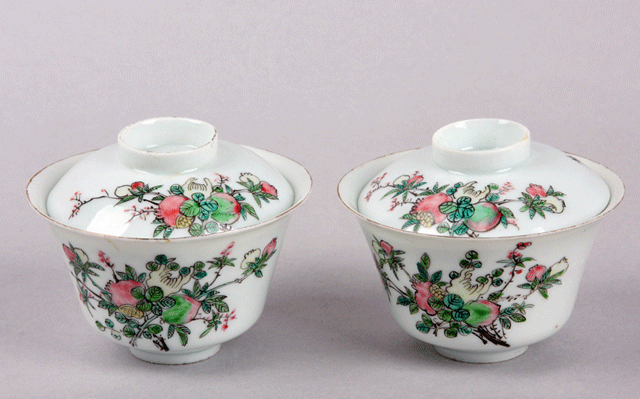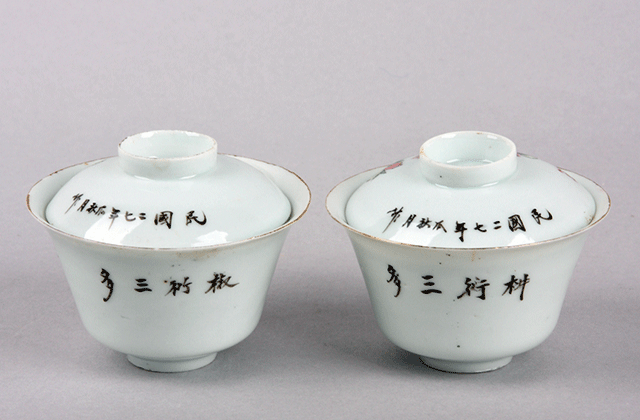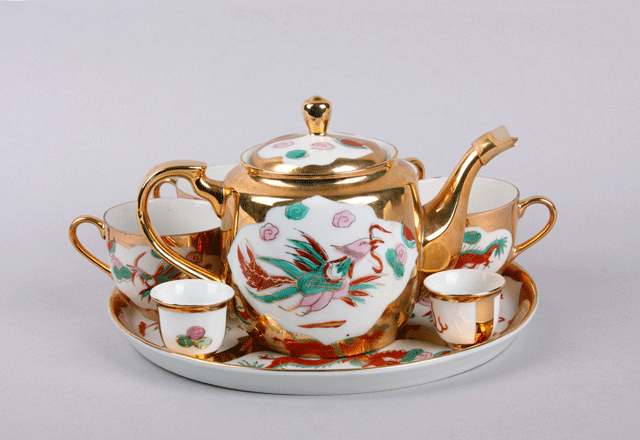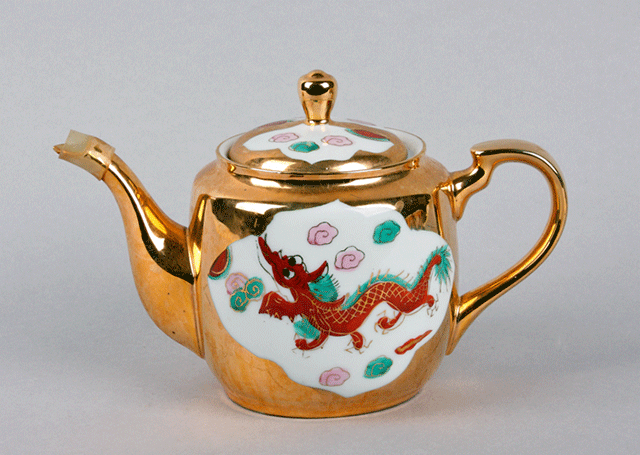

Siu G. Wong, OD, MPH writes:
These fragile porcelain tea cups came to the U.S. from Shanghai with my parents, three sisters, and two brothers in 1945. The family landed in San Francisco but moved to Sacramento within a year because my father couldn't find a job to support his family (which soon included me, born in San Francisco). Throughout my childhood these tea cups were never used; they were too fragile for everyday life. Instead they were a reminder of my family's affluent lifestyle prior to the Japanese occupation of China in the late 1930s and early 1940s. That long-vanished life included servants, an amah, a gardener, and the first automobile in our small neighborhood.
My father, Edwin Kwong Wong, was born in 1900 to a poor family in southern Guangzhou Province. He emigrated to the U.S. and was interned on Angel Island, California for four months before being released. He went to high school in Berkeley, received a B.S. from Ohio State University, and obtained an M.S. in ceramic engineering from Penn State. My father knew the value of education and hoped to return to China to help build and modernize a country wracked by civil strife and famine. My father's college days were a mix of study, hunger, and fun. On many days his three daily meals were apples, which he stored under his bed. In later days he talked about the coach who told him to exercise, to eat good food instead of junk food, and to take cold showers!
Like many of his generation who were educated overseas, my father returned to China to modernize the country and in particular, its electrical and water systems. He found a job as a management supervisor for General Electric (GE) in Shanghai, and worked on fluorescent light bulb design.
When my father decided to marry, his preference was for an educated woman. An interesting concept during the early 1900s, but it underscored the value he placed on education. My mother, Loo Yod Yung (Wong) was born in Hong Kong in 1909. My mother's father owned a hotel, other real estate, and a shipping company and was also a Christian missionary to the U.S. My maternal grandparents were very progressive for the era, and my mother was educated in a Catholic school and became a school teacher. Because my grandmother was in ill health and wanted her daughter to wed as soon as possible, my parents wed seven days after they met. While this arranged marriage happened quickly, my grandmother was in favor of it because my father was educated and had clear goals and a bright future.
My parents lived through the Japanese occupation of Shanghai (1937–1945), including through World War II. Those were very difficult years. Because my father worked for an American company (GE) and was a bilingual American citizen, our family managed to survive the deprivations and restrictions of life in an occupied country. In 1945 the Red Cross secured a cabin for the family on a troop ship sailing to America, and my parents left behind everything that they couldn't bring on the ship. Among the few items they did bring along were the peach blossom tea cups I now own.
Once the family was in the U.S., my mother told my brothers and sisters to behave because they were guests in the country and would be returning to their homeland. My father still believed that he could help build a better China. GE asked my father to return to to his old work but when the communists took over the country, my parents decided to remain in the U.S.
My parents' 59 year marriage was built on love, sharing, and respect.
My father worked three jobs to keep the family together and at first, my mother
worked in a cannery. I can still smell the tomatoes from her clothes and
apron! The hardships they endured for their children's sake was reciprocated
by the respect we showed our parents. We understood that to make our parents
proud and to be successful, we needed a college education. My parents
lived to see each child graduate from college and become a success in his or
her chosen profession.
The following is based on information provided by Mr. Bo Jin of the Hunan Museum.
Dr. Wong's two cups are gaiwan (bowl with lid) type tea cups. Originally the cups and lids came with saucers (but the saucers didn't make it to the U.S.). The two gaiwan were made in the Min Guo (post-imperial) period, in the autumn of 1938. They were made at Jingdezhen, Jianxi Province, the porcelain capital of China. The painted designs were done by hand and used imported colors.
The flowers are San Duo, meaning "three abundances." Each type of abundance is symbolized by a particular fruit: prosperity by peaches, abundant children by pomegranates, and long life by foshou ("Buddha hand"). The backs of the gaiwan (shown below) include Chinese writing read from right to left, describing the "three abundances."

The backs of the tea cups and lids
Dr. Wong's personal collection also includes the gold dragon tea set shown
below. The tea set is
suitable for use in a traditional wedding. During the ceremony the bride serves
tea to the groom's family. The tea is first served to the oldest members of
the family (for example, grandparents), then to the groom's parents, aunts,
uncles, and older married siblings. In return, each relative offers a wedding
present of jewelry or lai see (a
red envelope of
lucky money).

Dr. Wong's gold dragon tea service

The other side of the tea pot
See source code for photo credits and copyright information. Page last revised on March 6, 2014. Please report problems to toh@unm.edu